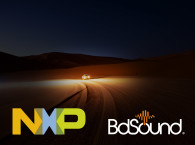 In this edition of audioXpress, our readers will find the latest insights on audio digital signal processing (DSP) applications, as they evolve from connected systems to on-device, on the edge, with artificial intelligence (AI)/machine learning (ML) integrations, and as hardware-agnostic software solutions. Our dedicated Market Update feature, titled “DSP Evolution: Audio Processing Powered by AI,” looks at the latest industry trends as companies on all product development fronts combine DSP algorithms with AI. That’s the vanguard of digital signal processing these days and lots of very clever things are already made possible because of AI.
In this edition of audioXpress, our readers will find the latest insights on audio digital signal processing (DSP) applications, as they evolve from connected systems to on-device, on the edge, with artificial intelligence (AI)/machine learning (ML) integrations, and as hardware-agnostic software solutions. Our dedicated Market Update feature, titled “DSP Evolution: Audio Processing Powered by AI,” looks at the latest industry trends as companies on all product development fronts combine DSP algorithms with AI. That’s the vanguard of digital signal processing these days and lots of very clever things are already made possible because of AI.
Most audio devices are exploring sophisticated DSP by combining calculations performed remotely, in the cloud, and stored for active processing on the local device. Now, the industry is being challenged to move those demanding DSP tasks directly to mobile and wearable, ultra-low-power devices - the most challenging examples of which are the tiny true wireless earbuds, which are a best-selling product category for the past five years. To take these challenges even further, new designs need to process real-time data from sensors in tandem with audio signals, powered by very efficient tiny embedded computers. And neural networks, ML, and AI are becoming key parts of the core engines needed to orchestrate all the available data to convert it into fully adaptive audio experiences.
And when DSP and AI are able to happen directly on-device, the paradigm shifts. Current platforms are now capable of running intense computational tasks for real-time processing and consumers are starting to feel the benefits. Voice commands, voice interfaces, and digital assistants are only the most visible demonstration of what these extremely powerful platforms are able to offer.
Complementing this month's market update on DSP, Roger Shively (JJR Acoustics) writes about Automotive Audio and how the unique acoustic space of the car interior can be defined by the use of DSP. Either to control the soundfield to simply balance the tonal quality of the audio playback, or to reproduce the auditory illusion of a larger event space where the apparent width or placement of a source can be enhanced. An interesting overview of the latest techniques, offered with a unique practical perspective.
Also related to our DSP focus, audioXpress is honored to feature an article written by Al Clark (CEO, Danville Signal Processing), sharing his company’s R&D journey into the development of the dspNexus DSP Audio Processor. An interesting inside story about how the author’s experience led him to maximize the possibilities of digital audio, resulting in successfully bringing to market a dedicated DSP audio processor that could be used as a control center, a preamplifier, and a DSP engine for powered loudspeaker applications.
Also highlighted for this month’s edition of audioXpress is the intriguing Phonitor One d Headphone Amplifier System, designed by SPL of Germany. Stuart Yaniger shares his impressions and measurements of this headphone amp for consumers, which uses the company’s unique 120V circuitry, and also features an acclaimed AKM premium USB DAC and balanced stereo line output, effectively enabling it to function as a combination DAC and preamp. An interesting design also because of its Phonitor Matrix, a unique feature designed to electronically create a crosstalk signal and generate something similar to the effect of acoustic crosstalk around our head when listening through headphones. This is one of the first models in a new Series One product line from SPL that combines the sound of the company’s studio-oriented designs at an affordable price.
In this month’s Sound Control column, Richard Honeycutt shares details about a real-life project for an A/V recording complex that represented a double challenge. First solving significant acoustic and noise challenges of adapting an industrial open office building. Second, to address creating A/V recording facilities inside the building with all the predictable acoustical design challenges.
Transitioning to Audio Electronics, this edition of audioXpress also features Part 2 of “Ultra-Linear Amplifiers: Why It Works (And When It Will Not)” by Morgan Jones. After reviewing the basic tenets of ultra-linear operation and looking into the detailed operation with several tube types, the author addresses the questions: Does it contribute power to the load, or is it purely negative feedback? What does the g2 current waveform look like? How do we ensure that ultra-linear works well? This second article details some of the author’s findings and interesting conclusions.
And another valuable audio electronics article in this edition is Morty Tarr’s second take on “Amplifier Design: Cascodes, Folded Cascodes, and Current Mirrors.” Expanding on the author’s analysis of these circuit topologies that are used to provide specific functions for an amplifier design, intended to improve its performance, but also adding complications, this second part details findings in current mirrors and line stages. As he writes, “As designers, we have many devices to choose from. Some devices are ideally suited to certain tasks. Other tasks require performance that is difficult to achieve. While many excellent devices exist today, ideal devices do not exist, except maybe in Spice simulations.”

And this November 2021 edition of audioXpress will be certainly valued by the inclusion of an important research piece on the "History of the American Magnetic Head Industry" by Scott Dorsey. An article several years in the making, it could as easily have resulted in an interesting reference book, given the extensive scope of the topic. In this article for audioXpress, Scott shares his research into tape recording, centered on the American industry, watching how companies evolved and noting the people who made contributions to this key component of audio technology.
audioXpress is published 12 times per year, and available in print and online. Subscribing to the digital online version allows immediate access and is available here:
www.audioxpress.com/page/audioXpress-Subscription-Services.html
If you wish to buy a single printed issue or the complete audioXpress archive on USB, from 2000 to 2021 (yes, including the latest issue), just visit our online shop at www.cc-webshop.com
Don't miss out, get your copy of audioXpress right now at www.gotomyxpress.com






